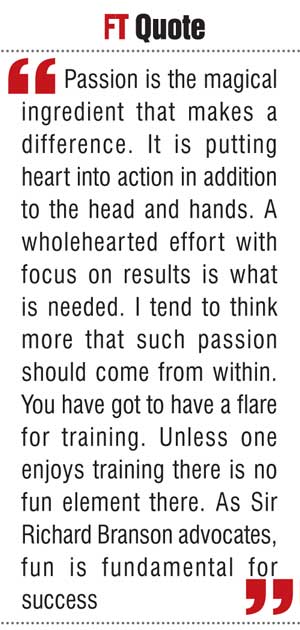Sunday Apr 20, 2025
Sunday Apr 20, 2025
Monday, 26 September 2016 00:01 - - {{hitsCtrl.values.hits}}
Talent is in high demand both locally and globally. We saw a wave of writings such as ‘Winning the War for Talent’ spreading the word. We have witnessed the dire consequences of not having the right talent in the right place, in both the private and public sectors. Talent development becomes vital in this context. Today’s column is a reflection of the actions needed by talent developers in terms of highlighting the required norms.
 Overview
Overview
We are discussing a wide span of actions, including formal education and informal training. Let me focus more on management training. This is because I am not only a management learner and teacher but also a management trainer. Furthermore, at a time when training has become more a commercial engagement than a capability enhancement, re-examining its roots and results is of importance.
Training can be regarded as the formal and informal processes that an organisation uses to facilitate employees’ learning so that their resultant behaviour contributes to the attainment of organisational goals. An example for a formal process could be a classroom session. An informal process takes the shape of observations, understudying or guidance.
I see a mushrooming of trainers in Sri Lanka with the mailbox getting flooded with many details of training programs. While noting the positive aspect of it in catering to the unmet needs of the market, my concern is over quality and relevance. Simply because someone has the gift of the gab does not necessarily mean that he or she can become a trainer. Knowing the depth and breadth of the topic is essential.
Clarity on commandments
According to the Oxford Dictionary, a commandment is an authoritative direction or instruction to do something. In the context of management training, this direction may come from the leaders of an organisation or in a very broad sense it can be viewed as a set of guidelines for effective training. Let’s look at what they possibly are.
One: Thou shalt conduct proper need analysis
The story of talent development through training begins with needs analysis. For me, training is a gap-filler. You have to identify the gaps with regard to knowledge, skills and attitudes. For example, someone who is very good in accounting but not very comfortable in dealing with Microsoft Excel. That’s a gap which needs to be filled through appropriate training.
If this is not done the whole purpose is lost. That’s why some of the off-the-shelf programs might not match the exact needs of an organisation.
Two: Thou shalt set SMART objectives
Once needs are identified, objectives have to be set in order to ensure the results. I have one sad observation. Most of the electronic brochures on training I get daily do not contain the objectives. Having fancy images or smiling faces of trainers is one thing. What is more important is to spell out the Specific, Measurable, Agreed, Realistic and Time-bound (SMART) objectives.
In some cases such as attitudinal training, it might be difficult to have SMART objectives. Yet, you can work around it to have a certain sense of measurement. Only then does the evaluation become meaningful.
Three: Thou shalt design the program meaningfully
This is all about beginning with the end in mind. Being proactive in identifying the needs and setting objectives appropriately has to be done. The design of the training is critical to the delivery. It is like the plan of a building. Many trainers spend less time in design and exert more energy in delivery, which may lead to an interesting yet ineffective session.
This reminds me of what Walt Disney advocated for the designing of training. As Tom Peters and Robert Waterman describe in their seminal work, ‘In Search of Excellence’, Walt Disney was meticulous in designing training for Disney characters such as Mickey Mouse and Donald Duck. Disney followed three basic steps in being a dreamer, realist and a critic.
Dreamer: Wearing a dreamer’s hat to unleash creativity, in imagining a wide array of possibilities.
Realist: Wearing a realist’s hat in pruning the possibilities to a manageable, feasible level.
Critic: Wearing a critic’s hat in making the design practical by challenging assumptions.
 Four: Thou shalt ensure proper delivery of the program
Four: Thou shalt ensure proper delivery of the program
The proof of the pudding is in the eating and this is the acid test. It requires purpose, passion and performance. A trainer must be very clear about his purpose in front of the participants. Clear thinking leads to clever action. Without getting derailed by participants’ queries, overall purpose should be in mind like a compass always pointing north.
Passion is the magical ingredient that makes a difference. It is putting heart into action in addition to the head and hands. A wholehearted effort with focus on results is what is needed. I tend to think more that such passion should come from within. You have got to have a flare for training. Unless one enjoys training there is no fun element there. As Sir Richard Branson advocates, fun is fundamental for success.
A talent developer playing the role of a trainer has to be a performer. It is very transparent and digital. Evaluation by the participants is the true customer feedback. What is in need is not a list of excuses for pitfalls but a live experience of excellent performance.
Five: Thou shalt prepare adequately
Preparation is a vital aspect for the smooth delivery of training. Like the old saying goes, “If you fail to prepare, you prepare to fail”. It reminds me of a true event that took place in Europe. There was a violinist who produced a mesmerising performance in one of the grand theatres. The audience gave her a standing ovation. A little girl who was a violin fan walked up to her after the show and told her, “I would like to spend half of my life to learn to play the violin the way you played.” The answer was prompt, “I actually did.”
Hence the mantra for excellent delivery is none other than rehearsing, rehearsing and more rehearsing.
Six: Thou shalt obtain feedback
Mercer Consulting in its annual global surveys consequently identified training effectiveness as one of the most important HR measurements. It is vital for sustained talent development.
This refers to the reaction level identified by Donald Kirkpatrick. It relates to how trainees reacted to their training. In other words, how much they liked it or disliked it. Some organisations are very proud of compiling an evaluation sheet at the end of the training and getting the overall measure. For me it gives only a ‘feel’ of the training effectiveness.
Some trainers are very smart at declaring a money back guarantee if the evaluation rating is below a specific percentage. It does not cover the reality of application challenges and is just a case of thriving on feelings.
Seven: Thou shalt assess the learning taken place
It can be either ‘know what’ or ‘know how’ referring to knowledge and skills respectively. This is the second stage, which is the learning level according to Kirkpatrick. It is directed at measuring trainees’ performance in terms of their knowledge, skills and attitudes against the criteria which were set for the period of the training.
This generally means an end of the course assessment, comprising either a questionnaire to check the knowledge gained or a test to ascertain the skills acquired. A person who has undergone training in word processing may be asked to type a letter and obviously the letter is expected to be well-formatted and free of errors.
Eight: Thou shalt evaluate behavioural change
This focuses on the application of training and refers to Level 3 or the behaviour level of the Kirkpatrick model. It resonates well with what British author Aldous Huxley said a long time ago. “At the end of the day, what matters is not how much you know but how much you have done”. Knowing should lead to doing and doing should bring the desired results.
At this stage, the focus shifts from the training context to the work environment. How effectively the knowledge, skills and attitudinal enhancement gained from training have transferred to the job is measured here. The immediate supervisor can play a critical role in this respect by providing feedback based on his/her observations of the trainee.
Nine: Thou shalt be aware of the impact of the initiatives
Now it is the time to focus on returns at a macro level. Return on Investment (ROI) or Return on Training Investment (ROTI) appears prominently in this regard. What Kirkpatrick calls the results level (Level 4), deals with how to measure this important aspect. It involves complex calculations to establish benefits against costs, with a high amount of assumptions.
In order to get the results the training should fulfil financial and non-financial expectations. In areas such as sales it is relatively easier to measure the impact at the results level by using simple comparisons such as sales before and after the training. With regard to other areas involving knowledge and attitudinal enhancements, the situation is much more difficult with the involvement of multiple contributing factors towards results other than training.
Ten: Thou shalt genuinely develop talent for prosperity
Talent development through training has a wide span. With economic growth and business expansion, both public and private sector organisations tend to focus more on training. Such a scenario demands the trainers to play their role by exceeding expectations. That requires them to do some soul-searching with a view of enhancing one’s training competencies. It is no more a game of going behind corporate decision-makers seeking opportunities. It is a case of competing on competencies so that caring and committed trainers will get more and more occupied.
Way forward
For me investing in talent development through training, which is on the rise, is a good thing. Yet, not measuring the effectiveness of it is a sad thing. In Sri Lanka, individuals and institutions alike can play a role in this regard. May the Ten Commandments for talent developers pave the way for such endeavours.